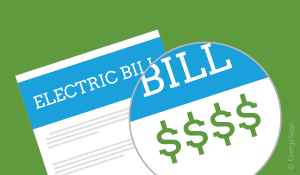
Just what utility rate payers who complain about growing electricity bills probably didn’t want to hear….but according to a new report by the U.S. Energy Information Administration, their electricity bills grew by 2% every month in 2023 but inflation grew faster.
In other words, inflation was greater than their increased utility bills.
The EIA reported the 2% electricity rate compared 2023 rates to 2022 and it was slower than the 2023 inflation rate of 4.1%.
In nominal terms (not adjusted for inflation), the average monthly electricity bill for residential customers in the United States in 2023 totaled $138, an increase from $135 in 2022. This 2% increase was in line with the 2% average annual increase over the past decade. The 2023 data are preliminarily based on a sample of utilities, although the 2013 through 2022 data are final data based on more extensive utility data collected by the EIA. Among individual states, average monthly residential electricity bills ranged from a low of $87 in Utah to a high of $213 in Hawaii.
Monthly electricity bills are affected by two factors: electricity prices and the amount of grid-delivered electricity that customers consume. The EIA, in its study, did not directly survey electricity prices or bills. Rather, it estimates bills by dividing the utilities’ revenue from residential customers by those customers’ electricity consumption.
On average, higher electricity prices were offset by declining consumption in 2023. The average U.S. residential electricity price rose 6.2%, from 15.04 cents per kilowatthour (kWh) in 2022 to 15.98 cents/kWh in 2023. Monthly electricity consumption per residential customer averaged 861 kWh in 2023, a slight decrease from the 899 kWh in 2022, which contributed to the average bill increasing less than the inflation rate.
At $213, Hawaii consumers had the highest average monthly bills in 2023. Electricity prices in Hawaii are high because petroleum-fired electricity generation is expensive compared with other fuels and because the island is not connected to another electricity grid. Although electricity prices are high in Hawaii, electricity consumption is among the lowest in the United States.
Utah consumers had the lowest average monthly bills; residents paid an average of $87 per month for electricity in 2023. Consumers in other southwestern states, including New Mexico and Colorado, also had bills well below the national average. These states tend to have lower-than-average residential electricity prices and consumption, and the delivered costs for coal and natural gas to power plants were lower than in 2022.
Residential consumers in Louisiana used more than four times the electricity as those in Hawaii on average. However, because electricity prices are so much lower in Louisiana, residents paid $142 per month, 33% less than those in Hawaii and just above the national average. Like other southern states, including Florida, Alabama, and Texas, Louisiana tends to have low electricity prices but more consumption because consumers typically use more air conditioning and are more likely to use electric space-heating equipment in the winter.
Source: EIA




